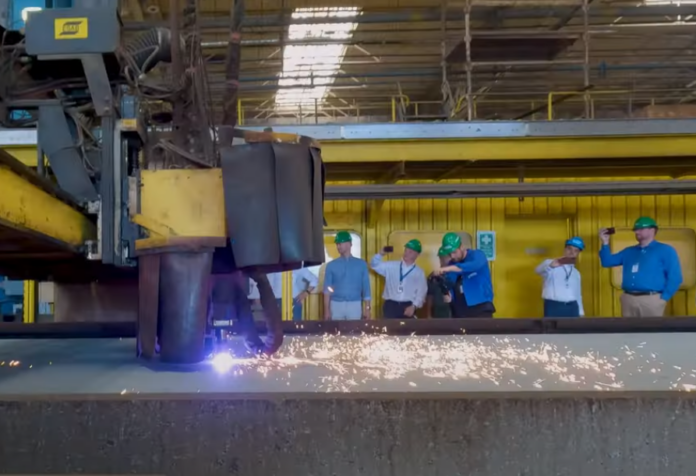
Construction has started on new battery-electric hybrid ferries for Campbell River and Nanaimo.
The shipyard in Romania which is building them, Damen Shipyards, had the steel cutting ceremony on Tuesday. Construction has now started on the first two of four new Island-class vessels, which will replace ferries on the Campbell River – Quadra Island route and the Nanaimo – Gabriola Island route.
The Island Nagalis and Island K’ulut’a currently serving Quadra Island are only a few years old and will be redeployed. BC Ferries says they will likely go to Hornby and Cortes Islands, both of which have ferries reaching the end of their service lives. The Crofton-Vesuvius route will also benefit from the fleet shuffle.
BC Ferries told Vista Radio the Quadra route has been identified as suitable for ships which can operate on battery power, and charged from the shore. The corporation says electrification is a major goal for the fleet, and has environmental benefits.
“Pursuing electrification is not only the right thing to do, but it aligns with our goals and community expectations for cleaner and quieter vessels, and helps with meeting emissions-reduction targets for the transportation sector,” the corporation said in an emailed statement.
BC Ferries says the new vessels will be the same or better as the current ferries for handling tides and winter weather.
New Ferries, By the Numbers
- 𝐈𝐧𝐜𝐫𝐞𝐚𝐬𝐞𝐝 𝐜𝐚𝐩𝐚𝐜𝐢𝐭𝐲: each vessel will accommodate nearly 47 vehicles and 400 passengers, providing greater service capacity and comfort for our customers.
- 𝐄𝐧𝐡𝐚𝐧𝐜𝐞𝐝 𝐞𝐧𝐯𝐢𝐫𝐨𝐧𝐦𝐞𝐧𝐭𝐚𝐥 𝐬𝐮𝐬𝐭𝐚𝐢𝐧𝐚𝐛𝐢𝐥𝐢𝐭𝐲: designed to operate on renewable @bchydro electricity, these vessels will significantly reduce our environmental footprint, supporting the Province’s CleanBC goals and bringing us closer to our 2030 targets by reducing emissions by 10,000 tons of CO2 equivalent.
- 𝐈𝐦𝐩𝐫𝐨𝐯𝐞𝐝 𝐜𝐫𝐞𝐰 𝐝𝐞𝐩𝐥𝐨𝐲𝐦𝐞𝐧𝐭: the new design will streamline crew operations, enhancing efficiency and effectiveness by having similar technology and protocols across the fleet.
- 𝐐𝐮𝐢𝐞𝐭𝐞𝐫 𝐬𝐡𝐢𝐩𝐬: the updated propulsion system will reduce underwater radiated noise, ensuring quieter operations – benefiting marine life and enhancing the overall passenger experience.





